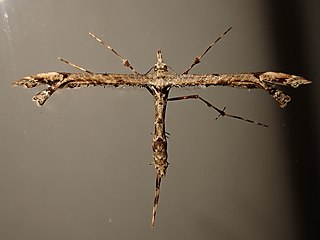Argidava is a genus of moths in the family Geometridae erected by Francis Walker in 1863.

Amblyptilia repletalis is a moth of the family Pterophoridae. It is endemic to New Zealand and can be found throughout the country.
Dichomeris contentella is a moth in the family Gelechiidae. It was described by Francis Walker in 1864. It is found on Borneo.
Dichomeris permundella is a moth in the family Gelechiidae. It was described by Francis Walker in 1864. It is found in Peru and Amazonas, Brazil.
Dichomeris sumptella is a moth in the family Gelechiidae. It was described by Francis Walker in 1864. It is found in Peru and Amazonas, Brazil.
Compsolechia abruptella is a moth of the family Gelechiidae. It was described by Francis Walker in 1864. It is found in Amazonas in Brazil and in Peru.
Compsolechia repandella is a moth of the family Gelechiidae. It was described by Francis Walker in 1864. It is found in Mexico, Colombia, southern Brazil and Guyana.
Compsolechia suspectella is a moth of the family Gelechiidae. It was described by Francis Walker in 1864. It is found in Amazonas, Brazil.
Compsolechia solidella is a moth of the family Gelechiidae. It was described by Francis Walker in 1864. It is found in Amazonas, Brazil.
Anacampsis conistica is a moth of the family Gelechiidae. It was described by Thomas de Grey, 6th Baron Walsingham, in 1910. It is found in Mexico.
Anacampsis pomaceella is a moth of the family Gelechiidae. It was described by Francis Walker in 1864. It is found in Amazonas, Brazil.
Anacampsis subactella is a moth of the family Gelechiidae. It was described by Francis Walker in 1864. It is found in Australia.
Lecithocera dissonella is a moth in the family Lecithoceridae. It was described by Francis Walker in 1864. It is found on Borneo.
Deltoplastis amicella is a moth in the family Lecithoceridae. It was described by Francis Walker in 1864. It is found in India (Assam), Myanmar and Sri Lanka.
Lichenaula afflictella is a moth in the family Xyloryctidae. It was described by Francis Walker in 1864. It is found in Australia, where it has been recorded from Queensland.
Anadasmus nonagriella is a moth in the family Depressariidae. It was described by Francis Walker in 1864. It is found in Panama, Peru, French Guiana and Amazonas, Brazil.
Antaeotricha indicatella is a moth in the family Depressariidae. It was described by Francis Walker in 1864. It is found in Amazonas, Brazil.
Antaeotricha umbriferella is a moth in the family Depressariidae. It was described by Francis Walker in 1864. It is found in Amazonas, Brazil.
Cerconota armiferella is a moth in the family Depressariidae. It was described by Francis Walker in 1864. It is found in Amazonas, Brazil.

Tingena apertella is a species of moth in the family Oecophoridae. It is endemic to New Zealand and can be found in both the North and South Islands. Adults are on the wing from November to January and the species is common in beech forests at approximately 2000 ft. At rest on the ground this species appears very similar to a yellow beech leaf.

